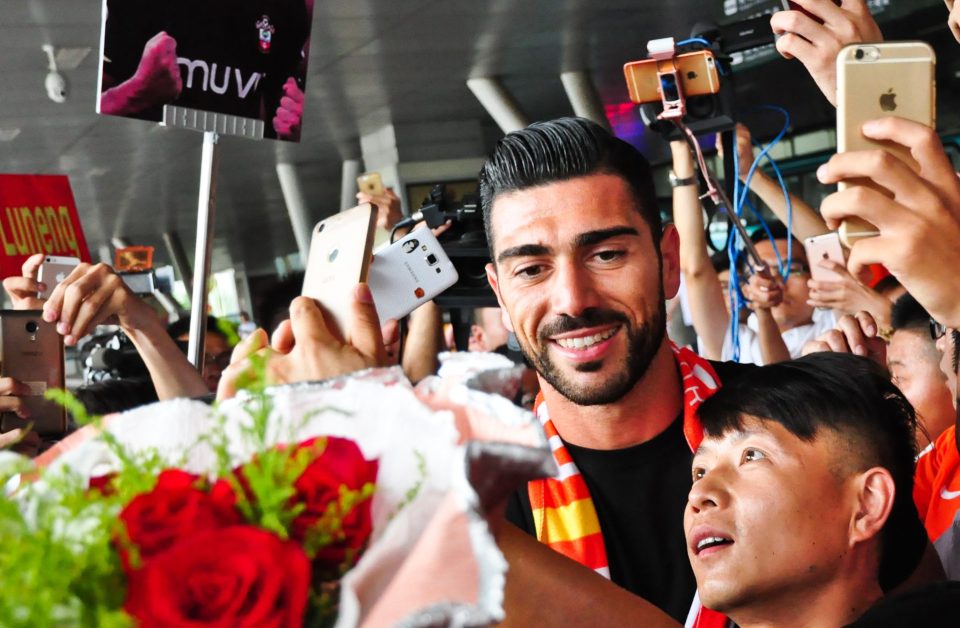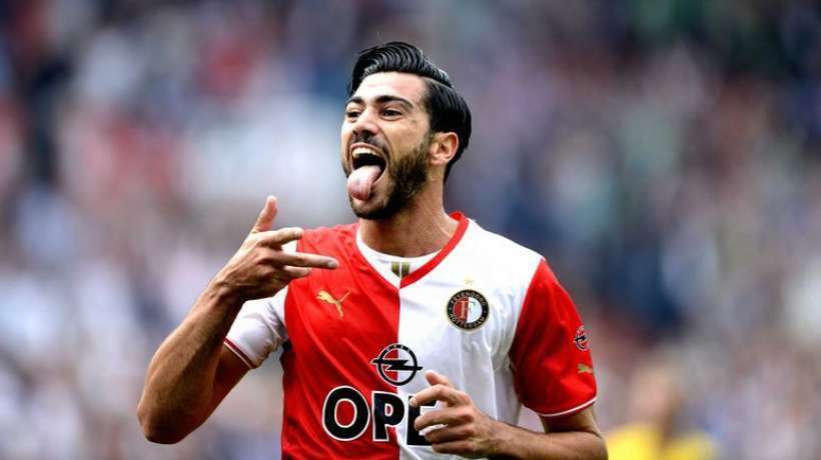“Why Asia? First of all, I went there because it was far, it gave me the impression of a place where there was still something to discover. I went there in search of “the other”, of everything I didn’t know, chasing ideas, men and stories I had only read about.”
These eloquent words were spoken by Tiziano Terzani, Italian writer and journalist who spent his whole life on the Asian continent. But the motivations behind Terzani’s decision to migrate to China are not the same for everyone. Some might decide to reach the Far East for the sake of money, to enhance their career or, why not, to flee from something which torments them in the Occident, no matter where they go.A combination of these reasons probably lies behind Graziano Pellè’s choice to join the Chinese Super League last year.
A wage that made him the fifth richest footballer on Earth obviously played its role in the decision, but we cannot rule out that the ghost of Manuel Neuer was haunting the nights of the Italian centre-forward, after his infamous missed penalty contributed to sending Italy home at the quarter-finals of Euro 2016.
The act of miming a Panenka whilst engaging in mind games with Neuer, before shooting his penalty half-a-metre wide of the goalpost, is something most Italians haven’t been able to forgive, and has prompted a deluge of not-so-kind words since that unfortunate July evening.
But Graziano Pellè’s life wasn’t always like this. In the past, there were no Instagram photos shot on a rooftop with the Shanghai skyline behind, nor those taken on the Great Wall of China. There was just Graziano, a boy with typical Mediterranean traits born in San Cesario di Lecce, a sun-drenched town of 8,000 people not far from Lecce, in the wonderful region of Apulia.His father Roberto, class of ’54, was a football player whose career unfolded between Italy’s minor leagues, playing for Lecce, Potenza, Torres, Civitavecchiese and Squinzano. Despite having a father that played with Sergio Brio (283 appearances with Juventus), the young Graziano, was at first fascinated by another sport. He was a dancer. His mother used to bring him to the dance school after training at Copertino, his first football team. After a quick change of dress inside the car, he was ready to show everybody his rhythmic talent, which helped him win the Italian title in the Latin, ballroom and standard categories.
Nevertheless, it was not long before Graziano, named after the 1982 World Cup winner Francesco “Ciccio” Graziani, fell in love with the beautiful game. In 2002, Lecce brought him to their youth team, where he won the Campionato Primavera at the first attempt. Two years later, he was already making his debut in Serie A, against Bologna. From that point on, life travelled fast for Pellè, and he began roaming around Italy and then Europe.
In the winter of 2005 he was sent to Catania on loan, in Serie B. After his Sicilian spell, it has been said that Real Madrid even bid for him, though nobody has ever confirmed what seems a fanciful rumour. In any case, the legend goes that Lecce turned down the offer and kept Pellè with them for the 2005-06 season, though he struggled and failed to score his first top-flight goal. After a couple loans at Crotone and Cesena in Serie B, his good season with the black-and-whites saw him selected for the 2007 European Under-21 Championship held in the Netherlands.
It is here that his career encountered its first turning point. Louis van Gaal, AZ Alkmaar’s manager at the time, had watched the young Italian at the championships and wanted him at all costs, and Pellè duly joined the Dutch side a week after the Under-21 Championship. He was 22 back then, and his transfer sparked off the usual refrain in Italy: ‘He’s young and he’s being forced to grow up abroad, like Italian engineers and physicians, because in our country we’re not able to give value to young talents, regardless of the field they belong to.’
This is something that has long been one of the major problems for Italian football. But 10 years ago, Graziano Pellè was not an accomplished talent and had only managed to score a handful of goals in the second tier. No wonder Lecce didn’t think twice when presented with the chance of selling this tall, yet undistinguished striker for a good £5 million.
Things were different in the Netherlands. Pellè secured a regular spot in AZ’s starting line-up – something he struggled to do in Italy – and started to gain confidence. However, though van Gaal took a liking to the Italian, the other AZ coaches (namely Ronald Koeman and Dick Advocaat) remained unconvinced. Indeed, whilst Pellè put in some good performances and the experience as a whole was far from a complete disappointment, the Prima Punta only registered 14 goals over four seasons. This tally was too modest for one who was supposed to frighten opposition defenses with his powerful physique and good feet. Without many regrets, like the ones Lecce had never had in 2007, AZ let him return to his home country in 2011.
Not the bargain of the year, as public opinion said back then, but he was a player still deemed useful for a team like Parma. Unfortunately, he only scored one goal, in a 3 – 3 draw against his former team Lecce, and in January, the Crociati decided to loan him to Sampdoria. The Blucerchiati were struggling to restore their Serie A status after being relegated at the end of a disastrous 2010-11 season. In those few months, six of the 67 points Sampdoria earned were due to Pellè’s four goals. Samp ended the season in sixth, earning promotion through the play-offs.
As for Graziano, he made his way back to Parma at the end of the season, and from there he moved to the Netherlands once again, this time to Rotterdam to play with the Feyenoord. In this grayish city, something finally started to click. Graziano played regularly under his former coach Koeman, who saw that the Italian had matured since his years at AZ. Suddenly, Pellè was the talisman and he re-paid Koeman’s trust with 29 goals, which helped Feyenoord to a third place finish and ensured the Italian became a fan favourite.
Pellè in action for Feyenoord, where he became something of a cult hero.
His second spell in the Netherlands continued with another great season, which attracted the attention of Southampton. After having signed a deal with the Saints, Pellé, still under the direction of Ronald Koeman, helped the team with 16 goals in total, guiding them to Europa League qualification. From a young age, he had demonstrated fine touch and technique in addition to his strong physique. Moreover, he was a graceful player compared to other forwards his size, perhaps honed during his dancing days. But at Feyenoord and Southampton, he was able to add that that much sought-after trait: consistency. Graziano was now ready for the next step.On 13 October 2014, at 29-years-old, he made his debut for Italy during the Euro 2016 qualifiers. In what was a dismal affair against Malta, he scored Italy’s only goal, grabbing the headlines the following day, which celebrated him as “a saviour”. In a short space of time, he went from debutant to leading centre-forward, as Antonio Conte decided to rely on him full-time.
Then Euro 2016 arrived, and the rest is recent history. It started very well for Pellè, who scored two goals in the tournament, one against Belgium in a group game and one against Spain in the Last 16. That was until those cursed shoot-outs in the quarter-final against Germany.
And now, the story goes back to where it started. From that very night, Pellè’s life changed. After Euro 2016 elimination, he faced accusations that he was a disrespectful player, and people mocked him on the internet for that stupid penalty. But, just when he was in the saddest moment of his career, an unexpected lifeline appeared. A lifeline made of 24 carat gold and diamonds, thrown by a Chinese tycoon ready to pay him a salary higher than the GDP of Tuvalu.
Graziano Pellè became one of the jewels of the Chinese league, part of a wave of luxury signings to arrive after football frenzy started sweeping the most populated country in the world. He made his official debut with the full-orange kit of Shandong Luneng Taishan on 16 July 2016.
Despite the cultural adaptations every ‘Westerner’ has to face before getting used to the Asian environment, Pellè is doing quite well in his new Chinese life. Thus far, he has scored six goals in the Chinese Super League, but his detractors will be happy to know that he has not lost the habit of taking penalties in the same way he did against Germany.
Words by Franco Ficetola
Franco is a son of Rome who grew up admiring Totti’s assists and chasing a ball through the streets of the capital’s suburbs.


